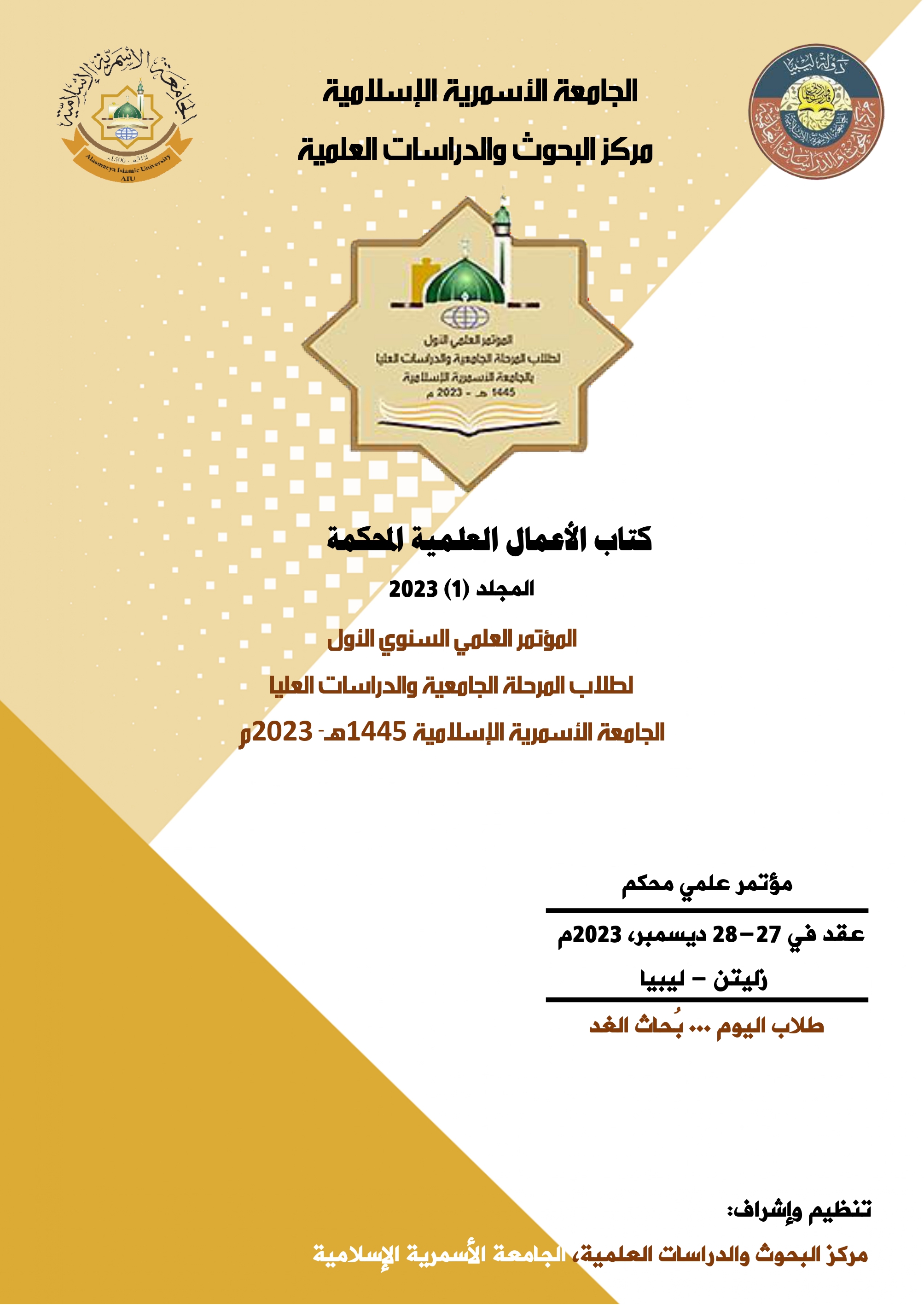تقييم جدوى فحم البرتقال كمادة مازة لإزالة صبغة الميثيل البرتقالي من المحاليل المائية
الكلمات المفتاحية:
الميثيل البرتقالي، فحم البرتقال، أيزوثيرمات الإمتزاز، حركية الإمتزاز، الإمتزاز، التنشيط الكيميائيالملخص
هدفت هذه الدراسة إلى استكشاف استخدام فحم البرتقال، والذي يمكن الحصول عليه بتكلفة منخفضة من الأسواق المحلية في ليبيا، كممتز فعال لإزالة الميثيل البرتقالي من المحاليل المائية. أصبح التخلص من الأصباغ في البيئة، بما في ذلك الميثيل البرتقالي مصدر قلق عالمي بسبب تأثيره السلبي على موارد المياه. بحثت الدراسة في تأثير العوامل المختلفة مثل التركيز ووقت التلامس ودرجة الحموضة وجرعة الممتزات وسرعة التحريض على عملية الامتزاز في التجارب على دفعات عند درجة حرارة 25oم لكل التجارب وتقييم كفاءة الامتزاز، والخواص الحركية، ومتساويات التوازن المرتبطة بإزالة الميثيل البرتقالي. أظهرت النتائج أن فحم البرتقال المنشط كيميائيا بحامض الهيدروكلوريك HCL كان مادة مازة فعالة لإزالة الميثيل البرتقالي، وقد تم تحديد قدرة الامتصاص للممتز باستخدام متساوي درجة حرارة Freundlich. خلصت الدراسة إلى أن نموذج الدرجة الثانية الزائف كان مناسبًا جيدًا للبيانات التجريبية. باختصار تشير هذه الدراسة إلى أن فحم البرتقال المنشط كيميائيا بواسطة حامض الهيدروكلوريك HCL يمكن أن يكون مادة مفيدة وفعالة من حيث التكلفة لإزالة الميثيل البرتقالي من المحاليل المائية.
التنزيلات
المراجع
Ajaz, M., Shakeel, S., & Rehman, A. (2020). Microbial use for azo dye degradation-a strategy for dye bioremediation. International Microbiology, 23, 149-159.
Al-Rubaie, L. A. A. R., & Mhessn, R. J. (2012). Synthesis and characterization of azo dye para red and new derivatives. E-Journal of Chemistry, 9(1), 465-470.
Aruna Janani, V., Gokul, D., Dhivya, N., Nesarani, A., Mukilan, K., Suresh Kumar, A., & Vignesh Kumar, M. (2023). Optimization Studies on Methyl Orange (MO) Dye Adsorption using Activated Carbon Nanoadsorbent of Ocimum basilicum Linn Leaves. Journal of Nanomaterials, 1-14.
Ayawei, N., Ekubo, A. T., Wankasi, D., & Dikio, E. D. (2015). Adsorption of congo red by Ni/Al-CO3: equilibrium, thermodynamic and kinetic studies. Oriental Journal of Chemistry, 31(3), 1307.
Baloo, L., Isa, M. H., Sapari, N. B., Jagaba, A. H., Wei, L. J., Yavari, S., ... & Vasu, R. (2021). Adsorptive removal of methylene blue and acid orange 10 dyes from aqueous solutions using oil palm wastes-derived activated carbons. Alexandria Engineering Journal, 60(6), 5611-5629.
Benkhaya, S., M'rabet, S., & El Harfi, A. (2020). Classifications, properties, recent synthesis and applications of azo dyes. Heliyon, 6(1), e03271.
Chen, S., Zhang, J., Zhang, C., Yue, Q., Li, Y., & Li, C. (2010). Equilibrium and kinetic studies of methyl orange and methyl violet adsorption on activated carbon derived from Phragmites australis. Desalination, 252(1-3), 149-156.
Elmorsi, T. M. (2011). Equilibrium isotherms and kinetic studies of removal of methylene blue dye by adsorption onto miswak leaves as a natural adsorbent. Journal of Environmental Protection, 2(06), 817-827.
Hashemian, S., Ardakani, M. K., & Salehifar, H. (2013). Kinetics and thermodynamics of adsorption methylene blue onto tea waste/CuFe2O4 composite. American Journal of Analytical Chemistry, 4(7A), 1-7.
Hosny, N. M., Gomaa, I., & Elmahgary, M. G. (2023). Adsorption of polluted dyes from water by transition metal oxides: A review. Applied Surface Science Advances, 15, 100395.
McBride, M. B. (1997). A critique of diffuse double layer models applied to colloid and surface chemistry. Clays and Clay minerals, 45, 598-608.
Mehra, S., Singh, M., & Chadha, P. (2021). Adverse impact of textile dyes on the aquatic environment as well as on human beings. Toxicol. Int, 28(2), 165.
Moradi, O., Pudineh, A., & Sedaghat, S. (2022). Synthesis and characterization Agar/GO/ZnO NPs nanocomposite for removal of methylene blue and methyl orange as azo dyes from food industrial effluents. Food and chemical toxicology, 169, 113412.
Parvin, F., Islam, S., Akm, S. I., Urmy, Z., & Ahmed, S. (2020). A study on the solutions of environment pollutions and worker’s health problems caused by textile manufacturing operations. Biomed. J. Sci. Tech. Res, 28, 21831-21844.
Popli, S., & Patel, U. D. (2015). Destruction of azo dyes by anaerobic–aerobic sequential biological treatment: a review. International Journal of Environmental Science and Technology, 12, 405-420.
Rovira, J., & Domingo, J. L. (2019). Human health risks due to exposure to inorganic and organic chemicals from textiles: A review. Environmental Research, 168, 62-69.
Salleh, M. A. M., Mahmoud, D. K., Karim, W. A. W. A., & Idris, A. (2011). Cationic and anionic dye adsorption by agricultural solid wastes: a comprehensive review. Desalination, 280(1-3), 1-13.
Sha, Y., Mathew, I., Cui, Q., Clay, M., Gao, F., Zhang, X. J., & Gu, Z. (2016). Rapid degradation of azo dye methyl orange using hollow cobalt nanoparticles. Chemosphere, 144, 1530-1535.
Zhao, Y., Zhao, C., Yang, Y., Li, Z., Qiu, X., Gao, J., & Ji, M. (2022). Adsorption of sulfamethoxazole on polypyrrole decorated volcanics over a wide pH range: mechanisms and site energy distribution consideration. Separation and Purification Technology, 283, 120165.
التنزيلات
منشور
إصدار
القسم
الرخصة
الحقوق الفكرية (c) 2023 اسويسي عطية الحسلوك، محمد علي الديب، ناصر سالم القيش

هذا العمل مرخص بموجب Creative Commons Attribution 4.0 International License.





